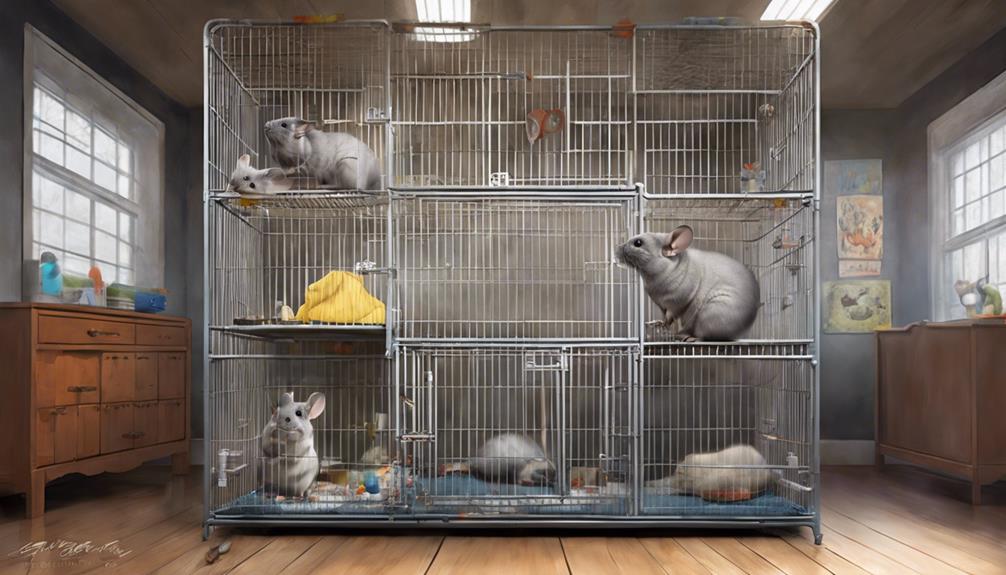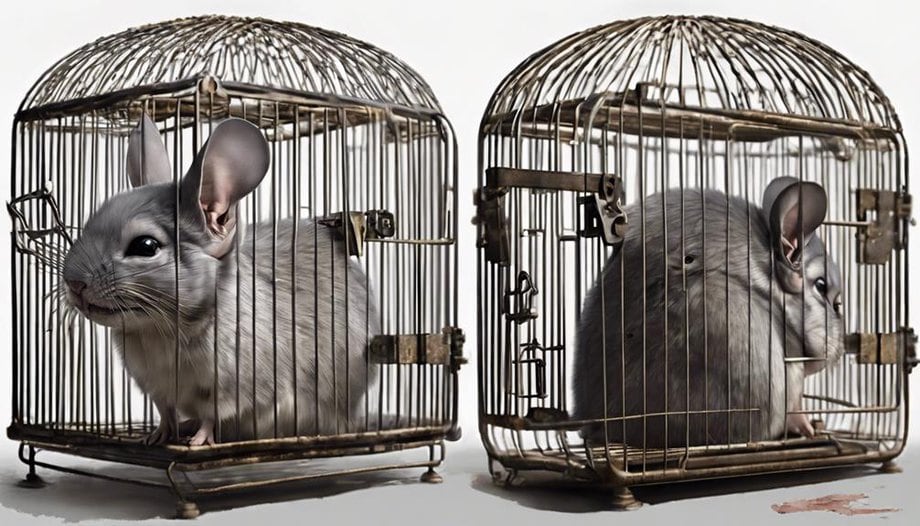How to Make Your Chinchilla's Cage Escape-Proof

When it comes to ensuring your chinchilla's cage is escape-proof, there are several key strategies you can implement:
- Secure the cage doors with sturdy locks or clips to prevent your chinchilla from pushing them open.
- Check the cage regularly for any signs of wear and tear, such as loose bars or gaps that your chinchilla could squeeze through.
- Place the cage in a secure location away from potential hazards, such as other pets or household items that could harm your chinchilla.
- Make sure the cage is large enough to provide ample space for your chinchilla to move around comfortably without feeling cramped.
By following these strategies and being diligent in monitoring your chinchilla's cage, you can help keep your pet safe and secure at all times.
Key Takeaways
- Secure cage doors with sturdy locks and latches to prevent escapes.
- Choose a well-ventilated cage with safe materials and proper temperature control.
- Conduct regular maintenance checks to ensure cage integrity and security.
- Provide safe accessories and eliminate potential hazards to enhance escape-proofing.
Secure the Cage Doors
To prevent your chinchilla from escaping, secure the cage doors with sturdy locks and latches. Door reinforcement is vital to make sure that your furry friend remains safely enclosed. Check the cage door hinges regularly to guarantee they're intact and functioning correctly. A reliable lock mechanism is essential in deterring any escape attempts by your curious pet.
When selecting locks and latches for your chinchilla's cage, prioritize latch security. Opt for robust materials that will withstand any potential tampering by your intelligent pet. Make certain that the locks are easy for you to operate but challenging for your chinchilla to manipulate.
Regularly inspect the cage doors for any signs of wear or damage. Replace any worn-out components promptly to maintain the security of the enclosure. By implementing these measures, you can create a secure environment for your chinchilla, allowing them the freedom to explore without the risk of escape.
Choose a Sturdy Cage Material
When selecting a cage material for your chinchilla, prioritize durability and strength to guarantee a secure enclosure. Here are some essential factors to contemplate:
- Cage material selection: Opt for materials like metal wire or stainless steel for their durability and resistance to chewing. Avoid materials like plastic or wood that can be easily damaged by your chinchilla's sharp teeth.
- Durability vs. aesthetics: While aesthetics are important, never compromise the safety of your chinchilla for the sake of looks. Choose a material that's both visually pleasing and durable to make sure your pet's security.
- Cage maintenance, Rust prevention techniques: Regularly inspect the cage for any signs of rust, especially in metal cages. Keep the cage clean and dry to prevent rust formation. Utilize rust-preventive coatings or sprays to extend the lifespan of the cage and maintain its sturdiness.
Provide Ample Ventilation
How can you guarantee your chinchilla's cage has sufficient airflow to maintain their health and well-being?
Ventilation placement plays an important role in ensuring your chinchilla's cage is escape-proof while providing adequate air circulation. When setting up your chinchilla's habitat, consider placing the cage in a well-ventilated area free from drafts. Positioning the cage near a window or in a room with good airflow can help regulate the temperature and keep the air fresh for your furry friend.
Additionally, opting for a cage with mesh walls or wire spacing that allows for proper ventilation without compromising security is essential. This design choice promotes air exchange and prevents stuffiness within the enclosure.
Eliminate Small Gaps and Holes
Ensuring your chinchilla's cage is escape-proof starts with meticulously sealing off any small gaps and holes that could compromise its security.
- Gap prevention is essential for chinchilla safety. Even the tiniest openings can be an invitation for your furry friend to explore the great unknown beyond its cage. Regularly inspect the cage for any small crevices where a chinchilla could squeeze through.
- Consider cage modifications or DIY solutions to address these small gaps and holes. Use safe materials that won't harm your chinchilla if chewed on. Cover any openings with sturdy mesh or metal grates to prevent escape attempts.
- Remember, chinchillas are curious and agile creatures, so be thorough in your gap-checking process. A meticulous approach to sealing off these potential escape routes will give you peace of mind and your chinchilla the security it deserves.
Use Escape-Proof Locks and Latches

To prevent chinchillas from escaping, it's important to use high-quality locks and latches on their cage doors.
Ensuring that the locks are secure and the latches are in good condition can help maintain the integrity of the cage.
Secure Cage Doors
Consider incorporating sturdy padlocks and heavy-duty latches to secure your chinchilla's cage doors effectively and prevent any potential escapes. To assure a secure environment for your furry friend, follow these essential steps:
- Door Reinforcement: Strengthen the cage doors with additional bars or metal sheets to prevent any bending or tampering.
- Lock Mechanisms: Install reliable padlocks or combination locks that your chinchilla can't unfasten.
- Hinge Durability: Regularly check the hinges for any signs of wear and tear to maintain the door's stability.
Check Latch Quality
Check the latch quality of your chinchilla's cage by using escape-proof locks and latches to secure maximum security. When choosing locks and latches, prioritize latch durability for efficient escape prevention and lock strength for enhanced safety precautions. Here is a table highlighting key aspects to to consider:
| Aspect | Importance | Recommendation |
|---|---|---|
| Latch Durability | High | Opt for sturdy materials like metal for longevity |
| Lock Strength | Essential | Choose locks that are secure and not easily tampered with |
| Safety Precautions | Critical | Ensure the locks are non-toxic and don't pose a danger to your chinchilla |
Minimize Climbing Opportunities
Chinchillas are natural climbers, making it important to limit their opportunities to scale their cage. By securing cage openings and removing tall structures, owners can prevent potential escape attempts.
Additionally, covering any wire gaps will further minimize the chances of chinchillas finding a foothold to climb.
Secure Cage Openings
To prevent escapes, make sure that cage openings are securely fastened to minimize climbing opportunities for your chinchilla. Here are three essential measures to secure cage openings effectively:
- Locking Mechanisms: Install secure locks on all doors, windows, and openings to prevent your chinchilla from pushing them open. Consider using locks that are chinchilla-proof and require dexterity to open.
- Mesh Size: Check the size of the mesh on any openings to guarantee your chinchilla can't squeeze through or climb on it. Opt for small mesh sizes that are escape-proof for your furry friend.
- Inspect Regularly: Periodically inspect the cage openings for any signs of wear or damage that could compromise their security. Replace any worn-out parts promptly to maintain a secure environment for your chinchilla.
Remove Tall Structures
Inspect the chinchilla's cage for any tall structures that could potentially serve as climbing aids, and promptly remove them to minimize escape opportunities for your furry companion. Chinchillas are known for their chinchilla perching and cage acrobatics, so it's important to eliminate any items that might aid their escape. Tall structures such as branches, ropes, or ledges can give your chinchilla the leverage needed to scale the cage walls and find a way out. By focusing on cage decoration that prioritizes chinchilla safety over aesthetics, you create a secure environment that allows your pet freedom within safe boundaries. Remember, a well-designed cage not only prevents escapes but also promotes a happy and healthy chinchilla lifestyle.
| Tall Structures to Remove | Reasoning |
|---|---|
| Branches | Aid climbing |
| Ropes | Provide leverage |
| Ledges | Assist in scaling walls |
Cover Wire Gaps
To prevent escape attempts and guarantee your chinchilla's safety, it's crucial to cover any wire gaps in the cage to minimize opportunities for climbing. Here are three essential steps to make sure your chinchilla's enclosure is escape-proof:
- Install Gap Covers: Use gap covers or safety clips to seal off any small openings in the cage where your chinchilla could squeeze through.
- Use Secure Mesh: Opt for a cage with secure mesh that has small enough gaps to prevent your chinchilla from grabbing onto and climbing.
- Implement Lock Mechanisms: Make sure the cage has reliable lock mechanisms on all doors and openings to prevent any accidental escapes due to a latch coming loose.
Regularly Inspect and Maintain the Cage
Regularly checking and maintaining the cage is essential for ensuring your chinchilla's safety and well-being. Start by conducting routine cage inspections to identify any potential safety hazards or escape routes. Look for loose wires, gaps in the bars, or any signs of wear and tear that could compromise the cage's integrity. Implement safety measures such as securing all doors and latches properly to prevent any accidental openings that could lead to an escape.
Additionally, regularly clean the cage to remove any debris or buildup that could pose a risk to your chinchilla. Use maintenance tips like tightening screws, replacing worn-out parts, and ensuring that the cage is sturdy and secure. By staying vigilant and proactive in inspecting and maintaining your chinchilla's cage, you can create a safe and escape-proof environment that allows your pet to thrive without any worries.
Frequently Asked Questions
Can Chinchillas Chew Through Certain Cage Materials?
Chinchillas have strong teeth and can chew through certain cage materials if not durable enough. To prevent this, choose sturdy cages made of metal or hard plastic. Regularly check for damages and provide chinchillas with appropriate chew toys to satisfy their natural chewing habits.
What Are Some Common Signs That a Chinchilla Is Trying to Escape Its Cage?
Chinchilla behavior can indicate escape attempts, like excessive chewing or digging. Owners should watch for these signs. Cage modifications, such as sturdy materials and secure locks, are essential. Safety precautions are vital for preventing escapes.
How Often Should Escape-Proof Locks and Latches Be Checked for Wear and Tear?
Lock maintenance is essential for security checks. Regularly evaluate lock durability and chew resistance. Examine for wear and tear to prevent escapes. Verify latches frequently, ensuring they are secure to keep the chinchilla safe.
Are There Any Specific Types of Ventilation Systems That Are Best for Chinchilla Cages?
Proper ventilation in chinchilla cages guarantees fresh air circulation. Using safe materials like wire mesh panels can help maintain a healthy environment. Prioritizing your chinchilla's well-being by providing adequate airflow and secure materials is crucial.
How Can I Prevent My Chinchilla From Attempting to Escape Due to Boredom or Stress?
To prevent chinchillas from escaping due to boredom or stress, it's essential to provide enrichment activities and chinchilla toys. Understanding chinchilla behavior and optimizing cage layout can also help create a stimulating environment that reduces the likelihood of escape attempts.











